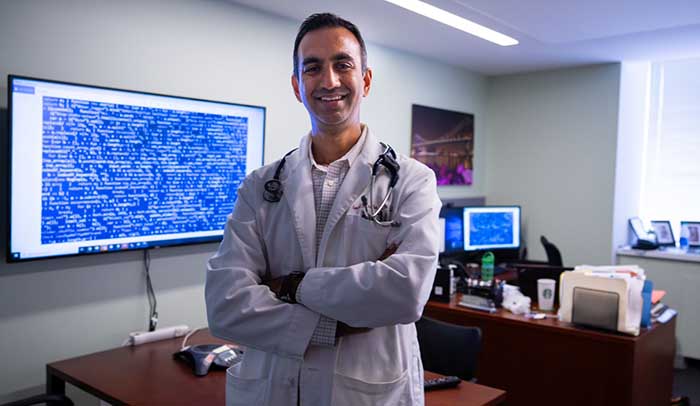Office of Research & Development |
 |
Office of Research & Development |
 |


Dr. Amol Navathe is a physician, health economist, and engineer. Among other areas, he has expertise in applying informatics and predictive analytics to health care. (Photo by Sam Shavers)
September 21, 2021
By Tamar Nordenberg
For VA Research Communications
"VA has long been on the forefront of using predictive analytics to improve patient care."
A few groups of VA researchers are using artificial intelligence (AI) to identify Veterans at high risk of hospitalization or death. That can help ensure these Veterans get the best care possible.
One potential approach was described in a recent article in the journal PLOS ONE. The research pinpointed subgroups of high-risk Veterans. The idea was to match patients with the right types of care, explains the study’s lead author, VA cancer physician and investigator Dr. Ravi Parikh.
His colleague, lead investigator Dr. Amol Navathe, a VA internal medicine physician and health economist, says, “Not only can this understanding of high-risk subgroups help doctors connect their patients with appropriate care strategies, but the knowledge can also support the development of improved VA care programs and strategies to target Veterans’ individual needs.”

Dr. Ravi Parikh is a cancer doctor with expertise in informatics and health care delivery. Among other areas, he studies the use of health technology—such as artificial intelligence—to improve routine patient care. (Photo by Sam Shavers)
The team looked at the records of Veterans already identified as high-risk by VA’s sophisticated Care Assessment Needs (CAN) calculator. The CAN tool provides a score reflecting a Veteran’s risk of hospitalization or death within a year.
“VA has long been on the forefront of using predictive analytics to improve patient care,” says Navathe, who works at VA’s Corporal Michael J. Crescenz VA Medical Center in Philadelphia and the University of Pennsylvania. “High-performing tools such as CAN are already used routinely in VA to estimate risk and ensure that highest-need Veterans are receiving beneficial interventions.”
The researchers wanted to take the information from CAN a step further, explains Parikh. He is an investigator with VA’s Center for Health Equity Research and Promotion (CHERP) and a cancer physician who, like Navathe, works at both the Philadelphia VA and the University of Pennsylvania.
“A Veteran might be in the 85th percentile in terms of health risk, but we examined why they were at such high risk, so VA care providers could identify effective targeted care strategies.”

AI to Maximize Treatment for Veterans with Head and Neck Cancer

VA Further Develops Its Central Biorepository: VA SHIELD

VA Launches Scott Hannon Initiative for Precision Mental Health
The study focused on 110,000 Veterans that CAN placed in the top 25 percent risk-wise. The team sought common traits among them, using data from VA’s advanced electronic health record system.
“We have an outstanding electronic health record system that includes granular details, down to cholesterol levels and blood pressure readings,” Navathe says.
Many additional features known to influence care and outcomes are also documented in the records. These include demographic features such as race and ethnicity, psychobehavioral factors like drug and alcohol use, and social restrictions like transportation limitations and inadequate housing that could impact access and care.
The team used a type of AI called machine learning to “read” through the records. With machine learning, computers imitate human intelligence, solving complex problems that often involve huge amounts of data. Medical record reviews with machine learning can identify patterns beyond the reach of a doctor’s traditional—and time-consuming—chart reviews.
The approach can “boil down immense amounts of information into a sort of CliffsNotes version,” Navathe explains.
The AI categorized data into 119 variables relating to Veterans’ medical conditions, demographics, vital signs, lab results, and other features. From there, the researchers identified 30 distinct subgroups of high-health risk Veterans. Of these, 21 subgroups related to medical conditions, such as kidney or liver disease and insulin-dependent diabetes. The remaining subgroups—relating to factors like gender, ethnicity, Medicaid coverage, or substance use—were not directly related to health conditions.
The aim is to be able to tell VA health care providers, “This patient is at high risk, and here is the subgroup he or she belongs to.” The information would also help the provider connect a high-risk patient to the right therapies and supportive care. Navathe offers examples:
This study is one of various VA initiatives—some using AI—designed to help Veterans with complex health care needs receive comprehensive, tailored, evidence-based care, says Parikh.
Harnessing the extensive data in health care records can help VA develop specialized care programs, especially for high-priority areas such as PTSD and traumatic brain injury. The approach can also inform VA about equity of care, Parikh adds. This can help ensure that Black Veterans and female Veterans, for example, receive equitable, high-quality VA care.
Targeted strategies for specific high-risk subgroups are needed, according to the researchers. They write, “‘One-size-fits-all’ care management programs have been shown to have limited success among high-risk individuals.”
Navathe predicts that, within a couple of years, machine learning will be routinely used in tools to support clinical care. “We envision machine learning being used down the line with CAN and other risk-stratification tools to help point the way to customized decisions about which intervention could be most beneficial for a particular patient.”
VA Research Currents archives || Sign up for VA Research updates